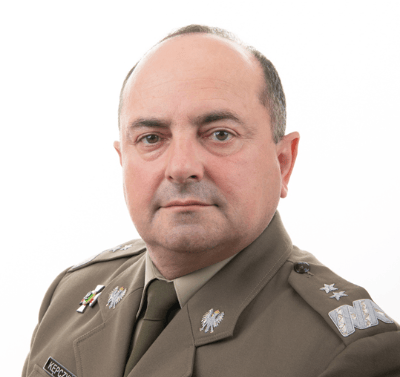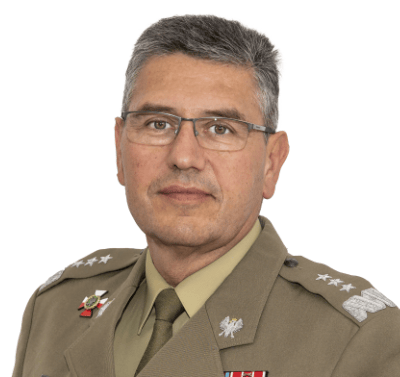Artur Kępczyński and Dariusz Łukowski

Artur Kępczyński
Inspectorate for Armed Forces Support, Polish Armed Forces

Dariusz Łukowski
Deputy Head of the National Security Bureau of Poland
Energy transformation – challenges to armed forces
BIO Major General Artur Kępczyński
Major General Artur Kępczyński is an active-duty soldier. Since 2021, he has served as the Chief of the Inspectorate for Armed Forces Support (IAFS). This command is responsible for providing logistic support to Polish soldiers both at home and abroad.
MG Kępczyński earned his B.Sc. degree from the Motor Transport Military Academy in Pila (Poland) and an M.Sc. degree in Mechanical Engineering from the Military Academy of Technology in Warsaw. Additionally, he completed Postgraduate Studies in Defence Policy at the War Studies University in Warsaw, as well as several NATO courses during his career.
Over the past 30 years, Major General Kępczyński has held various positions in the scope of logistics within the Polish Armed Forces in Poland and abroad in Polish Military Contingents (including UNIFIL in Lebanon from 1997 to 1998), as well as in NATO, EU, and UN commands. Notable positions include roles at the JHQ Center in Heidelberg, Germany (2001-2003); the Regional Operations Center AFSOUTH in Naples, Italy (2003-2004); and HQ EUFOR Tchad/RCA at Mount Valerien, France (2008-2009).
His scientific interests primarily focus on optimizing military logistics networks and ensuring the energy resilience of the armed forces.
BIO Lieutenant General Dariusz Lukowski
Lieutenant General Dariusz Lukowski - Deputy Head of the National Security Bureau of Poland
Education:
- Graduate of the Military University of Technology - master's degree (1988);
- Military Armament Institute of Technology - (engineer);
- University of Warsaw - Faculty of Law and Administration - postgraduate studies (1995);
- National Defense University Washington (USA) - postgraduate studies in defense policy (2008);
- Poznan University of Technology - PhD (2022).
Course of duty:
- 1988-1989 - commander of the command platoon of the 61st Air Defense Artillery Brigade;
- 1989-1993 - senior officer of the Armament and Electronics Department;
- 1993-1995 - General Staff of the PAF - senior officer of the service branch of the XV Division;
- 1996-1996 - General Staff of the PAF - Division XV, senior officer of the modernization deployment branch;
- 1996-2000 - General Staff of the PAF - Division XV, specialist of the land technology branch;
- 2000-2002 - General Logistics Division - P4, senior specialist of logistics resources branch - Logistics Planning Board;
- 2002-2004 - General Logistics Division - P4, deputy chief of the HNS branch;
- 2004-2006 - General Logistics Division - P4, chief specialist - Logistics Planning Board;
- 2005-2006 - Polish Military Contingent in the Republic of Iraq, branch chief-chief of logistics, logistics branch G-4,
- 2006-2007 - General Logistics Division - P4, chief of the board - Logistics Planning Board;
- 2008-2011 - commander of the 1st Logistics Brigade;
- 2009-2010 - PMC Afghanistan - Deputy Chief of Staff of ISAF Joint Command - DCOS SUPPORT IJC;
- 2011-2014 - Inspectorate of Armed Forces Support in Bydgoszcz, deputy chief of the Inspectorate - head of Logistics;
- 2012-2012 - PMC Afghanistan - observer;
- 2014-2016 - General Staff of the PAF - head of the Logistics Division - P4;
- 2016-2018 - head of the Armed Forces Support Inspectorate;
- 2019-2020 - deputy chief of the General Staff of the Polish
- 2020-2021 - advisor to the Chief of the National Security Bureau; 2021-2022 - director of the of Supervision Department over the Armed Forces , BBN;
- As of March 21, 2022, appointed deputy head of the National Security Bureau of Poland.
Appointments to subsequent military ranks:
- 1987 - second lieutenant;
- 1990 - lieutenant;
- 1994 - captain;
- 1998 - major;
- 2002 - lieutenant colonel;
- 2004 - colonel;
- 2008 - brigadier general;
- 2018 - major general;
- 2023 - lieutenant general.
ABSTRACT
All NATO nations are undergoing an energy transformation due to challenges related to climate protection, dependence on foreign energy resources, and advancements in new technologies. The implementation methods and legal frameworks vary, impacting the development of armed forces differently. This has a direct influence on each state’s defense policy and poses risks associated with potential variations in the adoption of new solutions for specific armed forces. Tests, analyses, and some completed implementations highlight limitations and challenges in electrifying combat platforms, emphasizing hybrid solutions. Despite this, the energy demand within armed forces continues to grow. Based on available data, it is unlikely that fully electric tactical vehicles will be introduced into armed forces before 2040.